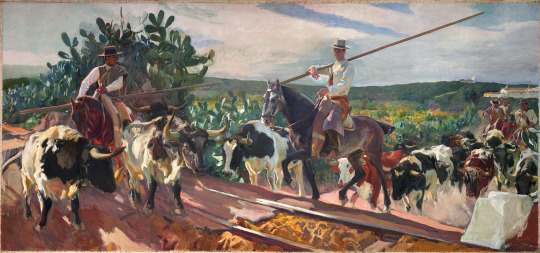IAP Interview: Marcus B. Burke, Senior Curator at the Hispanic Society of America
“For 112 years, we have been offering resources on Hispanic culture internationally, without charge, to all interested parties and visitors.”
NYFA recently had the opportunity to speak with Marcus B. Burke, Senior Curator at the Hispanic Society of America. Before his position with the Hispanic Society, Burke was the chief curator for the Meadows Museum, a guest curator at the Metropolitan Museum, the Art Museum at South Texas, and the Davenport Museum of Art. He has taught on the faculties of Yale, Columbia, and the NYU Institute of Fine Arts.
NYFA: You have been with the Hispanic Society for 22 years. Can you describe any favorite or memorable moments?
Marcus B. Burke (MB): The restoration of the Joaquín Sorolla murals (“Vision of Spain,” 1911-19) and the reconstruction of the roof and two interior walls of the part of the building that houses these large paintings – all of which took place over four years ending in the re-opening of the Sorolla murals room in May of 2010 – was surely the most important project of my tenure at the Society so far. Because we had to remove the roof (and build a temporary building over the existing structure), the pictures had to be removed. Since this involved rolling most of the pictures and removing them from the building, it became possible to exhibit them in Spain, as the painter and our founder had intended to do. For the event, the Foundation of Bancaja Valencia, the large regional savings bank at the time, offered to help us restore the paintings and give a large sum of money towards the reconstruction of the building. The paintings, which are nearly twelve feet high and run for nearly 200 linear feet in all, were painstakingly cleaned by a small army of conservators after more than a year of careful study, consultations, and detailed photography. They were then rolled, packed, and shipped in a dedicated Boeing 747 air cargo liner to Valencia, where they were unrolled, stretched, and put on display at the first of seven venues in Spain. In all, 2.2 million visitors saw the exhibition at the seven venues. The affair was so carefully managed that, after the paintings were brought back to New York and re-installed in their room in the current magnificent installation, we found that there had been no visible damage whatsoever. I can’t call this a “moment” because it was an ongoing project of long duration, but it was certainly the most memorable activity.
NYFA: How has the relationship between your audience and the museum evolved over your 22 years? Have you noticed any distinct shifts or have your methods of engaging Spanish-speaking communities changed?
MB: Our audience has always been local to New York City and its region, but also emphatically national and international. That has not changed. We have a great many international visitors, particularly from Spain and Latin America. We are one of the museums most sought after by Spanish tourists in North America.
We have always been bilingual English-Spanish in our programs, brochures, and outreach, to which occasionally Portuguese and Catalan have been added. If we go back 40 years, we see a tremendous change in the ethnic makeup of Washington Heights, the part of Upper Manhattan including Audubon Terrace, the block on Broadway between 155th and 156th Streets where our buildings are located. In particular, a former ethnically-mixed community with considerable Latino presence fell apart in the late 1960s and 1970s, to be replaced by a vibrant, family-centered Dominican community, and more recently, a new, broader ethnic mix. We are tremendously grateful in the way the Dominican community altered the life in the local barrio for the better.
At the same time, it has taken decades for the Society to engage the local community more effectively, which we have done through educational outreach and programs. This reflects partly a change in our education focus and partly socioeconomic changes in the age and situation of local residents. But our target communities extend far beyond our part of New York, to both Hispanic and non-Hispanic communities in the entire New York metropolitan region, as well as nationally and internationally. We were Hispanic before the city was (except of course to the extent that the first non-Native American resident of Manhattan in the 1600s was a Dominican). For 112 years, we have been offering resources on Hispanic culture internationally, without charge, to all interested parties and visitors. We are however, using new media and other contemporary means to try and get the word out in a wider and stronger way.

NYFA: Can you elaborate on the curatorial approach?
MB: Except for five years when the DIA Foundation exhibited here in a special gallery, we do not have a properly developed space for temporary exhibitions and therefore do not present loan or other temporary exhibitions. We will have a space in the future, and an exhibition program. We do loan and exhibit in collaboration with other institutions. These programs are developed on an ad hoc basis as the topic or opportunity arises. We have three curators in the Museum Department. Many of our outgoing loan exhibitions are quite large, but of course they will be exhibited in other locations, often out of the country.
We do, however, have monthly gallery talks, especially when we have new acquisitions, and artists are almost always in attendance at these programs. We have concerts, dance programs, and literary events as well, which of course involve performing artists. Similarly, we have an increasing list of Education Program events.
NYFA: You’ve mentioned your future plans around a space and exhibition program, at this time is there any vision of what they will look like?
MB: We have ideas about exhibitions, many including Latin American art, but the space is still in the planning stage, and any interior construction will involve architectural renovation aspects. It will be several years before we have the space and resources to mount temporary exhibitions. Meanwhile, we are repairing our century-old buildings and in fact will be putting a new roof on the main building in 2017.
NYFA: What resources are available for immigrant artists through the Hispanic Society?
MB: Our resources are cultural, visual, artistic, and literary. The Society preserves and promulgates the arts, literatures, and cultures of ancient Iberia, Medieval Iberia (including Islamic and Judaic), Spain, Portugal, Latin America, the Philippines, and anywhere else in the world that Spanish or Portuguese have been spoken languages.
It’s hard to say how any given artist or writer might make use of these resources. Under controlled circumstances, we do allow copying in paint media, and always allow drawing and non-flash still photography in the galleries. Full-blown film and video production companies have used the galleries for filming, but that is a complicated and expensive proposition for inside – the terrace is much more commonly used.
The curators are happy to interact with artists, which is more of a personal one-on-one matter. We do get requests to see works not on display, but we need the viewer to have a specific interest. Similarly, artists wishing to see rare books and manuscripts would need to have a specific interest, such as eighteenth-century bookbindings or manuscripts about a certain topic.
NYFA: If an artist is interested in doing more in-depth research or arranging a meeting, what are the best next steps?
MB: The first step is to look in our published catalogues, including exhibition catalogues, to get a sense of the collection, then come to visit and see the works currently on display, if one is already in the New York area. Once the artist has an idea of what kind of art (or even better, what specific objects) interest him or her, then he or she should communicate with one of the three divisions of the Society – the Museum Department, the Library (including manuscripts, rare books, and modern books), or the Prints and Photographs Department.
The important thing for objects not on display, however, is to have a specific need. With 23,000 unique objects in the Museum Department; 178,000 photographs; 18,000 prints and posters; 15,000 rare books before 1701; 20,000 modern rare books 1701-1830; 220,000 manuscripts; and a third of a million modern books and periodicals, the Society’s curators need potential visitors to narrow their research interests before contacting us.
The Society website has a “Contact” link, or a fax can be sent to 212-690-0743. The Society’s main phone number is 212-926-2234. The general email for the Museum Department is [email protected]. To consult modern books in the library, no appointment is necessary. The library opens on demand Tuesday-Saturday 10 AM to 4:15 PM – see the website for holidays. Rare books, manuscripts, prints, and photographs require appointments. To learn more about the Hispanic Society Museum and Library, click here.
Save the Date: NYFA Learning is delighted to announce a collaboration with the Hispanic Society for a presentation of NYFA’s Resources and Programs for Spanish-speaking artists which will take place on Thursday, October 13, 2016.
This interview originally appeared in the ConEdison Immigrant Artist Program Newsletter. Subscribe to this free monthly e-mail for artist’s features, opportunities and events here.
Images, from top: Joaquín Sorolla y Bastida (1863-1923), Provinces of Spain. Ayamonte. Courtesy of The Hispanic Society of America; Joaquín Sorolla y Bastida (1863-1923), Provinces of Spain. Andalucía. El Encierro, Courtesy of The Hispanic Society of America





